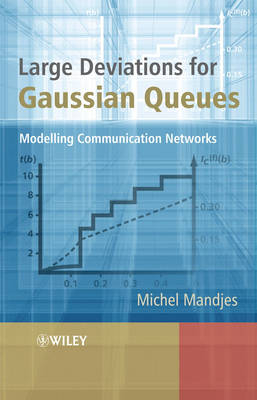
Large Deviations for Gaussian Queues
John Wiley & Sons Inc (Verlag)
978-0-470-01523-0 (ISBN)
In recent years the significance of Gaussian processes to communication networks has grown considerably. The inherent flexibility of the Gaussian traffic model enables the analysis, in a single mathematical framework, of systems with both long-range and short-range dependent input streams. Large Deviations for Gaussian Queues demonstrates how the Gaussian traffic model arises naturally, and how the analysis of the corresponding queuing model can be performed. The text provides a general introduction to Gaussian queues, and surveys recent research into the modelling of communications networks. Coverage includes:
Discussion of the theoretical concepts and practical aspects related to Gaussian traffic models.
Analysis of recent research asymptotic results for Gaussian queues, both in the large-buffer and many-sources regime.
An emphasis on rare-event analysis, relying on a variety of asymptotic techniques.
Examination of single-node FIFO queuing systems, as well as queues operating under more complex scheduling disciplines, and queuing networks.
A set of illustrative examples that directly relate to important practical problems in communication networking.
A large collection of instructive exercises and accompanying solutions.
Large Deviations for Gaussian Queues assumes minimal prior knowledge. It is ideally suited for postgraduate students in applied probability, operations research, computer science and electrical engineering. The book’s self-contained style makes it perfect for practitioners in the communications networking industry and for researchers in related areas.
Michel Mandjes, Centre for Mathematics and Computer Science (CWI) Amsterdam, The Netherlands, and Professor, Faculty of Engineering, University of Twente. At CWI Mandjes is a senior researcher and Director of the Advanced Communications Network group. He has published for 60 papers on queuing theory, networks, scheduling, and pricing of networks.
Preface and acknowledgments. 1 Introduction.
Part A: Gaussian traffic and large deviations.
2 The Gaussian source model.
2.1 Modeling network traffic.
2.2 Notation and preliminaries on Gaussian random variables.
2.3 Gaussian sources.
2.4 Generic examples-long-range dependence and smoothness.
2.5 Other useful Gaussian source models.
2.6 Applicability of Gaussian source models for network traffic.
3 Gaussian sources: validation, justification.
3.1 Validation.
3.2 Convergence of on-off traffic to a Gaussian process.
4 Large deviations for Gaussian processes.
4.1 Cram´er's theorem.
4.2 Schilder's theorem.
Part B: Large deviations of Gaussian queues.
5 Gaussian queues: an introduction.
5.1 Lindley's recursion, the steady-state buffer content.
5.2 Gaussian queues.
5.3 Special cases: Brownian motion and Brownian bridge.
5.4 A powerful approximation.
5.5 Asymptotics.
5.6 Large-buffer asymptotics.
6 Logarithmic many-sources asymptotics.
6.1 Many-sources asymptotics: the loss curve.
6.2 Duality between loss curve and variance function.
6.3 The buffer-bandwidth curve is convex.
7 Exact many-sources asymptotics.
7.1 Slotted time: results.
7.2 Slotted time: proofs.
7.3 Continuous time: results.
7.4 Continuous time: proofs.
8 Simulation.
8.1 Determining the simulation horizon.
8.2 Importance sampling algorithms.
8.3 Asymptotic efficiency.
8.4 Efficient estimation of the overflow probability.
9 Tandem and priority queues.
9.1 Tandem: model and preliminaries.
9.2 Tandem: lower bound on the decay rate.
9.3 Tandem: tightness of the decay rate.
9.4 Tandem: properties of the input rate path.
9.5 Tandem: examples.
9.6 Priority queues.
10 Generalized processor sharing.
10.1 Preliminaries on GPS.
10.2 Generic upper and lower bound on the overflow probability.
10.3 Lower bound on the decay rate: class 2 in underload.
10.4 Upper bound on the decay rate: class 2 in underload.
10.5 Analysis of the decay rate: class 2 in overload.
10.6 Discussion of the results.
10.7 Delay asymptotics.
11 Explicit results for short-range dependent inputs.
11.1 Asymptotically linear variance; some preliminaries.
11.2 Tandem queue with srd input.
11.3 Priority queue with srd input.
11.4 GPS queue with srd input.
11.5 Concluding remarks.
12 Brownian queues.
12.1 Single queue: detailed results.
12.2 Tandem: distribution of the downstream queue.
12.3 Tandem: joint distribution.
Part C: Applications.
13 Weight setting in GPS.
13.1 An optimal partitioning approach to weight setting.
13.2 Approximation of the overflow probabilities.
13.3 Fixed weights.
13.4 Realizable region.
14 A link dimensioning formula and empirical support.
14.1 Objectives, modeling, and analysis.
14.2 Numerical study.
14.3 Empirical study.
14.4 Implementation aspects.
15 Link dimensioning: indirect variance estimation.
15.1 Theoretical foundations.
15.2 Implementation issues.
15.3 Error analysis of the inversion procedure.
15.4 Validation.
16 A framework for bandwidth trading.
16.1 Bandwidth trading.
16.2 Model and preliminaries.
16.3 Single-link network.
16.4 Gaussian traffic; utility as a function of loss.
16.5 Sanov's theorem and its inverse.
16.6 Estimation of loss probabilities.
16.7 Numerical example.
Bibliography.
Index.
| Erscheint lt. Verlag | 23.5.2007 |
|---|---|
| Verlagsort | New York |
| Sprache | englisch |
| Maße | 158 x 235 mm |
| Gewicht | 599 g |
| Themenwelt | Mathematik / Informatik ► Mathematik ► Angewandte Mathematik |
| ISBN-10 | 0-470-01523-3 / 0470015233 |
| ISBN-13 | 978-0-470-01523-0 / 9780470015230 |
| Zustand | Neuware |
| Haben Sie eine Frage zum Produkt? |
aus dem Bereich


